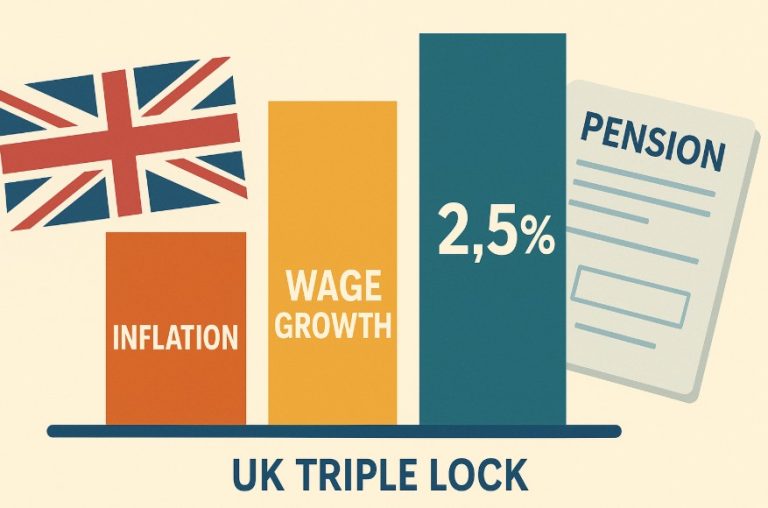The Civil Service pension increase for 2025 has been officially confirmed, bringing important updates for retired public sector employees across the UK. With inflation stabilising, pensioners will see a modest rise to support their cost of living.
This annual adjustment, based on the Consumer Prices Index (CPI), ensures that retirement benefits remain aligned with economic conditions.
In this article, we explore how the 2025 increase is calculated, who qualifies, and what it means for Civil Service pensioners.
What Is the Civil Service Pension Increase for 2025?

The annual Civil Service pension increase for 2025 is confirmed at 1.7%. This increase already applied from Monday, 7 April 2025, and is applied to pensions in payment as part of the government’s yearly review.
This process is governed by the Treasury Orders, following the Pensions (Increase) Act 1971. The figure is based on the Consumer Prices Index (CPI) from September 2024, which recorded a 1.7% inflation rate.
This represents a significant decrease from the previous years, which saw higher levels due to inflationary pressure during and after the pandemic.
The increase is intended to maintain the real value of pensions against the rising cost of living. All eligible pensioners should see their updated pension payments starting from April, though the timing and exact amount will depend on several eligibility factors.
The annual Pensions Increase and P60 mailing is used to communicate the details of this adjustment to retired members. This includes individualised calculations of the new pension rate and relevant tax information.
How Is the 2025 Pension Increase Calculated?
The calculation of the pension increase is closely tied to the Consumer Prices Index (CPI). The CPI figure from September 2024, which stood at 1.7%, forms the basis of the adjustment applied in April 2025.
This inflation-linked increase ensures that pension payments keep pace with rising living costs. The government uses the CPI rather than the Retail Prices Index (RPI), which was phased out for this purpose in 2011.
Eligibility for the increase is determined by the date the pension started. If a pensioner has been receiving their pension for the entire 2024/25 tax year, they will receive the full 1.7% increase. If the pension began partway through the year, the increase will be calculated on a pro-rata basis.
Here’s how that calculation works in practice:
Pro-Rata Pension Increase Example for 2025
| Retirement Month | Months Eligible | Pro-Rata Calculation | Final Increase Applied |
| April 2024 | 12 | 12/12 x 1.7% | 1.7% |
| September 2024 | 7 | 7/12 x 1.7% | 0.99% |
| December 2024 | 4 | 4/12 x 1.7% | 0.57% |
The pro-rata system ensures fairness by aligning the increase with the time a pension has been in payment during the tax year.
Why Might Some Pensioners Not Receive the Full 1.7% Increase?

While the Civil Service pension increase for 2025 is officially set at 1.7%, not every pensioner will see this full rise reflected in their payments. There are several reasons for this, all based on the rules of the scheme and the circumstances under which the pension is being received.
Pro-Rata Adjustments Based on Retirement Date
One of the most common reasons for receiving less than the full increase is pro-rata entitlement. The annual pension increase applies fully only to those who have been receiving their pension for the entire previous tax year.
If a pensioner retired partway through the 2024/25 financial year, they will receive an increase proportionate to the number of months their pension has been in payment. This ensures the increase fairly reflects the time the pension was drawn.
For example:
- A pensioner who retired in October 2024 would receive 6/12ths of the full 1.7% increase
- Someone who retired in January 2025 would receive 3/12ths of the full increase
This system is built into the Civil Service Pensions regulations and ensures that only the period in which the pension was paid is eligible for uprating.
Deferred Pensions Not Yet in Payment
Individuals with deferred pensions, that is, pensions they have earned but have not yet started to draw, will not receive the increase in 2025 unless their pension enters into payment during the relevant period.
Deferred pensions are normally adjusted under revaluation rules, which may apply a different rate than the annual Pension Increase.
In most cases, when the pension eventually comes into payment, it will reflect cumulative increases over time, but the exact uprating mechanism may differ depending on the scheme and date of service.
Overseas Residents and Uprating Agreements
Civil Service pensioners living outside the UK may also face restrictions on whether their pension is uprated each year. The UK government maintains reciprocal uprating agreements with some countries, meaning that annual increases are applied to pensions paid abroad.
However, pensioners living in countries without an uprating agreement may find their pension payments frozen at the level they were when they left the UK. Common examples include:
- Canada
- Australia
- New Zealand
- South Africa
In these cases, unless the UK enters a new agreement with that country, pension increases like the 1.7% for 2025 will not be applied.
Partial Retirement and Lump Sum Combinations
For members who have opted for partial retirement or chosen to take a lump sum as part of their pension benefit, the increase may apply only to certain portions of their pension.
This is particularly relevant in schemes like Alpha, where pension accrual is based on career-average earnings and annual revaluation.
In these scenarios, some parts of the pension may grow by the Treasury-determined revaluation rate (often CPI + 1.25%), while others follow the annual Pension Increase (PI) applied to pensions in payment.
Survivor and Dependant Pensions
Survivor pensions paid to spouses, partners, or dependants after a member’s death are also subject to annual increases, but the amount and eligibility may vary based on:
- The member’s scheme and service history
- Whether the survivor qualifies under current scheme rules
- The age of the surviving dependant
In many cases, survivor pensions receive the same increase as the primary pension, but it’s important for recipients to check their entitlement carefully.
Scheme-Specific Rules and Exceptions
Civil Service pensions are administered under several different schemes, including:
- Classic
- Classic Plus
- Premium
- Nuvos
- Alpha
Each of these schemes may have specific rules that affect how and when increases are applied. For example:
- Classic scheme pensions receive increases once in payment, in line with CPI
- Alpha scheme pensions (which are career average) receive annual revaluations while in service and Pension Increase after retirement
Members who have transitioned between schemes, or who have complex pension histories, may see different calculations depending on how their benefits are split across schemes.
How Does the Civil Service Pension Increase Compare to the State Pension?

The Civil Service pension increase of 1.7% is based on CPI, but this contrasts with how the State Pension is increased in the UK. The State Pension follows the Triple Lock Guarantee, which ensures it rises by the highest of:
- The rate of inflation (CPI)
- Average earnings growth
- 2.5%
As a result, the State Pension often sees larger increases than Civil Service pensions, particularly when earnings growth is high. In recent years, the State Pension has increased at rates above 6%, while the Civil Service pension rise has closely followed CPI.
Here’s a comparison:
Civil Service vs State Pension Increases (2023–2025)
| Year | Civil Service Pension Increase | State Pension Increase | CPI Reference | Notes |
| 2023 | 10.1% | 10.1% | Sept 2022 | High inflation |
| 2024 | 6.7% | 8.5% | Sept 2023 | Strong earnings growth |
| 2025 | 1.7% | TBC (Est. ~2.5%) | Sept 2024 | CPI-based; Triple Lock in effect |
It’s important to note that Civil Service pensions are defined benefit pensions, meaning they offer more security and predictability than many private schemes. However, they do not always match the State Pension’s annual percentage uplift due to the different uprating mechanisms used.
What Should Pensioners Expect in Their P60 and Increase Letter?
In April 2025, Civil Service pensioners will receive two important documents as part of the Spring communication package:
- A P60 certificate detailing the total pension and tax paid for the year
- A personal pension increase letter, outlining the new payment amount
These documents help pensioners understand how their payments are changing and ensure their tax records are up to date.
The increase letter will show:
- The new gross annual pension amount
- The date the increase takes effect
- Any pro-rata adjustment applied
- Contact information in case of discrepancies
Additionally, the Civil Service Pensions Scheme has made a short video available to help explain how to read the P60, ensuring clarity for those unfamiliar with the form.
This year’s P60 and pension increase letters are expected to arrive by mid-April 2025, shortly after the increase is applied.
How Can the Civil Service Retirement Fellowship Support Pensioners in 2025?
The Civil Service Retirement Fellowship (CSRF) is an independent charity that provides support to former civil servants, their families, and dependants. In 2025, it celebrates its 60th anniversary and will be hosting various activities and awareness campaigns.
The CSRF can support pensioners in areas such as:
- Combatting loneliness through telephone befriending
- Providing community engagement via local groups
- Offering guidance and wellbeing support
- Sharing news and updates on retirement rights and entitlements
Participation in CSRF activities can significantly enhance mental wellbeing, social interaction, and overall quality of life in retirement.
The CSRF also works closely with the Civil Service Pensions team to ensure members are aware of benefits and changes to their pension entitlements.
What Are the Broader Impacts on Pensioners in 2025?

While the pension increase for 2025 is modest, its impact should be viewed within the wider economic and policy context.
Key influences include:
- A decline in inflation, which means the cost of living is rising at a slower rate than in previous years
- Steady interest rates, affecting income from savings
- Potential changes to Inheritance Tax, expected from April 2027, which may affect estate planning for retirees
- Healthcare and support services being under pressure, impacting older individuals who may need greater support
Civil Service pensioners are advised to:
- Review their personal financial plans
- Consider the impact of modest pension increases on their budgeting
- Stay informed about upcoming policy changes
While the 1.7% rise may seem small, it is in line with inflation, helping pensioners retain their purchasing power in real terms.
How Can Civil Service Pensioners Stay Informed and Involved?
Civil Service pensioners have access to a wide range of tools and communications that help them stay up to date with changes to their benefits. These include:
- The official Civil Service Pensions website, which provides calculators, newsletters, and scheme updates
- Regular Pensioner Newsletters, such as the Spring 2025 edition, which covers key changes, guidance, and wellbeing tips
- Online feedback forms that allow pensioners to provide input on what they want to see in future communications
Pensioners are encouraged to use the available tools and stay connected, especially during periods of change. This ensures they make the most of their pension benefits and remain informed about entitlements and adjustments.
Conclusion
The 2025 Civil Service pension increase offers modest but essential support for pensioners, ensuring their income reflects current inflation trends.
While not as high as previous years, the 1.7% rise still protects long-term pension value. Understanding how the increase is applied helps pensioners manage expectations and plan their finances effectively.
Staying informed through official channels and using available resources will help pensioners make the most of their retirement income and any future changes to the Civil Service Pension Scheme.
FAQs About the Civil Service Pension Increase 2025
What date will the Civil Service pension increase take effect in 2025?
The increase will take effect from Monday, 7 April 2025, for most pensions in payment.
How does inflation influence the pension increase rate?
The annual increase is based on the Consumer Prices Index (CPI) figure from the previous September.
Can the pension increase be lower than inflation?
No, the increase reflects inflation but cannot exceed or undercut it unless CPI is negative, which has not occurred recently.
Will everyone get the 1.7% pension increase in full?
Only those who have been receiving their pension for the full tax year will get the full 1.7%. Others may receive a reduced, pro-rata amount.
What if I retired partway through the 2024/25 tax year?
You’ll receive a proportion of the full increase based on how many months you were retired during that tax year.
Does this pension increase affect survivor or dependent pensions?
Yes, survivor and dependent pensions are also adjusted annually in line with CPI, though rates may vary depending on the scheme rules.
How do I check if my pension was increased correctly?
You should review your annual P60 and pension increase letter. For further clarification, you can contact the Civil Service Pensions helpline.






